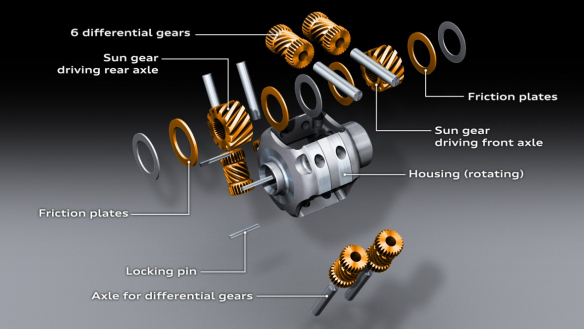Torsen differential
With the debut of the Audi 80 quattro in fall 1986, Audi introduced a new center differential – a component that was still strictly mechanical, but highly efficient. The name Torsen was a contraction of the words “torque” and “sensing.” The Torsen differential had already proved itself in the world of technology as a high-tech rear axle differential; Audi developed it further for use as a center differential.
The innovative feature of the Torsen differential was its arrangement of helical gears with special teeth cut at an angle to the gear axis. The two sun gears on the ends of the output shafts leading to the front and rear axles are each in mesh with three roller-shaped satellite gears; these are arranged in pairs in a triangle formation around the sun gears and each pair is interconnected via meshing spur gears. If the wheels of one axle cannot transmit the torque supplied, this creates friction in the helical gear train. The helical gears instantly and steplessly transfer the power to the axle with the greater traction.
The standard distribution was still 50:50, but, when needed, up to 75 percent flowed to the axle with the better traction. The Torsen differential locked only when under load. The differential was unlocked as soon as the driver took his or her foot off the gas, thus the ABS was always functional when it was needed. To further improve traction when starting under extreme conditions, the driver could still lock the rear-axle differential electro-pneumatically at the push of a button.
Status: 2011
